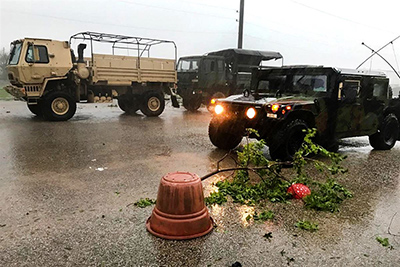LM survey highlights the impact and importance of emergency preparedness following recent hurricanes
A recent Logistics Management readership survey comprised of feedback from around 90 buyers of domestic and global freight transportation and logistics services showed that preparation and planning for an event such as Tropical Storm Harvey, from an emergency preparedness perspective, is crucial.

Preparing for any type of significant weather event, especially for freight transportation and logistics stakeholders, can be viewed as an inexact science to say the least. And dealing with the fallout of a major weather event such as Tropical Storm Harvey, which battered parts of Texas, Louisiana, and Florida in recent weeks, requires patience and perseverance among other traits.
A recent Logistics Management readership survey comprised of feedback from around 90 buyers of domestic and global freight transportation and logistics services showed that preparation and planning for an event such as Tropical Storm Harvey, from an emergency preparedness perspective, is crucial.
When asked if their logistics, supply chain, or freight transportation operations had been impacted by the hurricanes, 53.9% of respondents said yes, with 46.1% saying no. And when respondents were asked to what extent did Tropical Storm Harvey, impacted operations, 58.3% said it was “mild,” 33.3% labeled it as “medium,” with the remaining 8.3% calling it “severe.”
From a modal perspective, the mode which the majority of respondents said was mostly impacted because of Tropical Storm Harvey was trucking at 87.5%, followed by ocean at 25%, rail and intermodal at 20.8%, and air at 2.1%.
In terms of timing, just more than two-thirds of survey respondents indicated that the timeline in terms of how long it would take the parts of their supply chains impacted by Tropical Storm Harvey would be less than one month at 68.8%, and 12.5% expected it to be one-to-three months, 4.2%, respectively, for three-to-six months and six months or longer.
Regardless of the timeline and the degree to which Tropical Storm Harvey impacted operations, some common themes cited among the survey’s respondents focused on key supply chain strategies, and in some ways, essentials, like preparedness and communication, as well as preparing for the unexpected, too.
Candace Holowicki, director of global transportation and logistics at TriMas Corp., a diversified designer, manufacturer, and distributor of engineered and applied products serving a variety of industrial, commercial, and consumer end markets worldwide, explained that TriMas held outbound shipments until it could confirm with the consignee that they could receive the orders.
“The same lesson we ‘learn’ every time there is an unexpected disruption is that communication is key,” she said. “Cross functional communication could have improved how we handled this, before and after Harvey.”
An executive at a West Coast-based 3PL noted that her company made preparation in the form of business recovery management system that assisted it in coming back online quickly, clean up, securing client data, using state-of-the art technology.
Commentary relating to things such as asset allocation and inventory management was also top of mind after Tropical Storm Harvey hit, according to the survey’s respondents.
Keeping safety stock for spikes related to natural disasters was a common theme among respondents. Another one was focusing on the need to procure more advance inventory, and work with customers to get them what they need.
And increasing repair parts and stock, like tires and refrigeration, shelters for drivers and maintenance workers caught in the storm, paired with the need for locations for back up product and supplies and more specific information prior to potential disasters or disruptions was also seen as essential by respondents.
Coordination between carriers and shippers to stage specific items considered essential in forward areas was another cited strategy. A respondent said this requires holding balances at shipper locations or linehaul away from storm-related areas
But others pointed that is by no means a panacea either. Ed Evans, head of logistics at Alba Americas, a global aluminum smelter explained that with a weather event like Tropical Storm Harvey, “it would be cost prohibitive to move the inbound cargo further inland. As it is, drayage, storage, and reload are approximately equal to ocean freight costs.”
From a market perspective, both Irma and Harvey have accelerated the rate of tightening capacity fairly quickly, observed Stifel analyst John Larkin in a research note.
“As the emergency/rescue phase of the recovery winds down, we expect the rebuilding effort to kick off,” he wrote. “Demand for rebuilding supplies should be strong for an extended period. Capacity pulled into the rebuilding effort will leave other regions of the country underserved with capacity.”

Article Topics
News & Resources
Latest in Materials Handling
Geek+ and System Teknik deploy PopPick solution for pharmacy group Med24.dk Beckhoff USA opens new office in Austin, Texas Manhattan Associates selects TeamViewer as partner for warehouse vision picking ASME Foundation wins grant for technical workforce development The (Not So) Secret Weapons: How Key Cabinets and Asset Management Lockers Are Changing Supply Chain Operations MODEX C-Suite Interview with Harold Vanasse: The perfect blend of automation and sustainability Consultant and industry leader John M. Hill passes on at age 86 More Materials HandlingAbout the Author
Subscribe to Materials Handling Magazine

Find out what the world's most innovative companies are doing to improve productivity in their plants and distribution centers.
Start your FREE subscription today.
April 2024 Modern Materials Handling

Latest Resources










